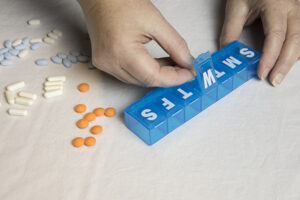August 12, 2025

Our caregivers help improve medication safety at home by supporting consistent routines and careful monitoring.
Does medication time feel like chaos at your house? With so many prescriptions and routines to keep straight, it’s easy to feel unsure if everything’s been taken as it should.
You’re not alone. With over 10,000 prescription medications in circulation in the U.S., it’s common for older adults to be taking multiple prescriptions each day. In fact, about one in three take five or more. That’s a lot to track, especially when each has its own set of instructions, potential side effects, and refill dates – making medication safety at home a challenge.
It’s no wonder that more than half of medications are taken incorrectly. But here’s the good news: you can avoid most of these errors with the right routine, tools, and support system in place.
Here are some smart strategies we recommend:
1. Have a Conversation About Each Medication
Take time to talk with your loved one’s healthcare provider or pharmacist about each prescription. Get clarity on:
- What each medication is treating
- The ideal time of day to take it
- Food or drink considerations
- Possible side effects to look for
- How long the medication is expected to be used
This helps you feel confident about the schedule and makes it easier to spot when something doesn’t seem quite right.
2. Build and Maintain a Medication Snapshot
Keeping a detailed, written medication list makes a world of difference. Your list should include:
- Prescription and over-the-counter medications, plus supplements
- Dosage, time of day, and purpose
- The prescribing provider’s name and contact info
- Any specific instructions (e.g., take with food, avoid grapefruit)
- The date it was last updated
Bonus tip: snap photos of each pill so they’re easy to identify at a glance.
3. Use Reminders That Fit Your Routine
What works for one family may not work for another. Some people do well with a color-coded pill organizer. Others prefer digital reminders that chime at set times each day. The key is to find a system that feels natural and repeatable.
Our caregivers can assist by offering medication reminders and helping to reinforce your loved one’s medication routine throughout the day.
4. Be Alert for Any Changes
Sometimes the signs of medication-related issues are subtle. You might notice your loved one seems sleepier, more forgetful, or suddenly has trouble with balance. Keep track of any physical or behavioral changes and pass them along to the prescribing provider for review.
Peace of Mind Starts With a Plan
Supporting someone with multiple medications at home doesn’t have to feel like guesswork. With a solid plan, the right resources, and a little extra help from Continuum’s award-winning care team, it’s entirely possible to simplify the process and reduce stress for everyone involved.
If your family is looking for dependable help with medication reminders or day-to-day routines, we’re here for you. We serve families across Chesterfield, Kirkwood, Creve Coeur, and throughout St. Louis and St. Charles counties with compassionate, customized home care.
Call us at (314) 863-9912 to find out how we can help
